Arbuscular Mycorrhizal Fungi as Biofertilizers to Increase the Plant Quality of Sour-Orange Seedlings
Abstract
1. Introduction
2. Materials and Methods
2.1. Plant Culture and Experimental Design
2.2. Growth and Plant Analysis
2.3. Determination of Mycorrhizal Colonization
2.4. Statistical Analysis
3. Results and Discussion
4. Conclusions
Author Contributions
Funding
Data Availability Statement
Acknowledgments
Conflicts of Interest
References
- FAO (Food and Agriculture Organization of the United Nations). Crop Prospects and Food Situation—Quarterly Global Report No. 1; FAO: Rome, Italy, 2020. [Google Scholar]
- GSDR (Global Sustainable Development Report) 2019. The Future Is Now—Science for Achieving Sustainable Development, Independent Group of Scientists Appointed by the Secretary-General; United Nations: New York, NY, USA, 2019. [Google Scholar]
- Suhag, M. Potential of biofertilizers to replace chemical fertilizers. Int. Adv. Res. J. Sci. Eng. Technol. 2016, 3, 163–167. [Google Scholar]
- Kuila, D.; Ghosh, S. Aspects, problems and utilization of Arbuscular Mycorrhizal (AM) application as bio-fertilizer in sustainable agriculture. Curr. Res. Microb. Sci. 2022, 3, 100107. [Google Scholar] [CrossRef] [PubMed]
- Raei, Y.; Shariati, J.; Weisany, W. Effect of biological fertilizers on seed oil, yield and yield components of safflower (Carthamus tinctorius L.) at different irrigation levels. J. Agric. Sci. Sustain. Prod. 2015, 25, 65–84. [Google Scholar]
- Khalediyan, N.; Weisany, W.; Schenk, P.M. Arbuscular mycorrhizae and rhizobacteria improve growth, nutritional status and essential oil production in Ocimum basilicum and Satureja hortensis. Ind. Crops Prod. 2021, 160, 113163. [Google Scholar] [CrossRef]
- Abobatta, W.F. Biofertilizers and citrus cultivation. MOJ Ecol. Environ. Sci. 2020, 5, 171–176. [Google Scholar] [CrossRef]
- Pathak, D.V.; Kumar, M.; Rani, K. Biofertilizer application in horticultural crops. In Microorganisms for Green Revolution. Microorganisms for Sustainability; Panpatte, D., Jhala, Y., Vyas, R., Shelat, H., Eds.; Springer: Berlin/Heidelberg, Germany, 2017; pp. 215–227. [Google Scholar]
- Hazarika, T.K.; Aheibam, B. Soil nutrient status, yield and quality of lemon (Citrus limon Burm.) cv. ‘Assam lemon’ as influenced by bio-fertilizers, organics and inorganic fertilizers. J. Plant Nutr. 2019, 42, 853–863. [Google Scholar] [CrossRef]
- Kottke, I.; Nebel, M. The evolution of mycorrhiza-like associations in liverworts: An update. New Phytol. 2005, 167, 330–334. [Google Scholar] [CrossRef]
- Ortas, I.; Rafique, M. The mechanisms of nutrient uptake by arbuscular mycorrhizae. In Mycorrhiza—Nutrient Uptake, Biocontrol, Ecorestoration; Varma, A., Prasad, R., Tuteja, N., Eds.; Springer: Cham, Switzerland, 2017; pp. 1–19. [Google Scholar]
- Makarov, M. The role of mycorrhiza in transformation of nitrogen compounds in soil and nitrogen nutrition of plants: A review. Eurasian Soil Sci. 2019, 52, 193–205. [Google Scholar] [CrossRef]
- Anand, K.; Pandey, G.K.; Kaur, T.; Pericak, O.; Olson, C.; Mohan, R.; Akansha, K.; Yadav, A.; Devi, R.; Kour, D.; et al. Arbuscular mycorrhizal fungi as a potential biofertilizers for agricultural sustainability. J. Appl. Biol. Biotechnol. 2022, 10 (Suppl. 1), 90–107. [Google Scholar] [CrossRef]
- Jansa, J.; Forczek, S.T.; Rozmos, M.; Puschel, D.; Bukovska, P.; Hrselova, H. Arbuscular mycorrhiza and soil organic nitrogen: Network of players and interactions. Chem. Biol. Technol. Agric. 2019, 6, 10. [Google Scholar] [CrossRef]
- Lu, F.; Lee, C.; Wang, C. The influence of arbuscular mycorrhizal fungi inoculation on yam (Dioscorea spp.) tuber weights and secondary metabolite content. Peer J. 2015, 3, 12–66. [Google Scholar] [CrossRef] [PubMed]
- Basiru, S.; Mwanza, H.P.; Hijri, M. Analysis of arbuscular mycorrhizal fungal inoculant benchmarks. Microorganisms 2021, 9, 81. [Google Scholar] [CrossRef] [PubMed]
- MAGRAMA. Anuario de Estadística Agraria 2021; Ministerio de Agricultura, Pesca y Alimentación, Madrid, Spain. Available online: https://www.mapa.gob.es/es/estadistica/temas/estadistica-diqital/ (accessed on 10 October 2023).
- Bates, B.C.; Kundzewicz, Z.W.; Wu, S.; Palutikof, J.P. Climate Change and Water; Technical paper of the Intergovernmental Panel on Climate Change; IPCC Secretariat: Geneva, Switzerland, 2008; p. 210. [Google Scholar]
- Navarro, J.M.; Antolinos, V.; Robles, J.M.; Botía, P. Citrus irrigation with desalinated seawater under a climate change scenario. Front. Plant Sci. 2022, 13, 909083. [Google Scholar] [CrossRef] [PubMed]
- Martínez-Alvarez, V.; González-Ortega, M.J.; Martin-Gorriz, B.; Soto-García, M.; Maestre-Valero, J.F. The use of desalinated seawater for crop irrigation in the Segura River Basin (south-eastern Spain). Desalination 2017, 422, 153–164. [Google Scholar] [CrossRef]
- Maas, E.V. Salinity and citriculture. Tree Physiol. 1993, 12, 195–216. [Google Scholar] [CrossRef] [PubMed]
- Grattan, S.R.; Díaz, F.J.; Pedrero, F.; Vivaldi, G.A. Assessing the suitability of saline wastewaters for irrigation of Citrus spp.: Emphasis on boron and specific-ion interactions. Agric. Water Manag. 2015, 157, 48–58. [Google Scholar] [CrossRef]
- Syvertsen, J.P.; Garcia-Sanchez, F. Multiple abiotic stresses occurring with salinity stress in citrus. Environ. Exp. Bot. 2014, 103, 128–137. [Google Scholar] [CrossRef]
- Ribeiro, R.V.; Espinoza-Núñez, E.; Junior, J.P.; Filho, F.A.A.M.; Machado, E.C. Citrus rootstocks for improving the horticultural performance and physiological responses under constraining environments. In Improvement of Crops in the Era of Climatic Changes; Ahmad, P., Wani, M., Azooz, M., Tran, L.S., Eds.; Springer: London, UK, 2014; pp. 1–37. [Google Scholar]
- Simón-Grao, S.; Nieves, M.; Martínez-Nicolás, J.J.; Cámara-Zapata, J.M.; Alfosea-Simón, M.; García-Sánchez, F. Response of three citrus genotypes used as rootstocks grown under boron excess conditions. Ecotoxicol. Environ. Saf. 2018, 159, 10–19. [Google Scholar] [CrossRef]
- Pérez-Pérez, J.G.; Porras, I.; Garcia-Lidon, A.; Botía, P.; Garcia-Sanchez, F. ‘Fino’ lemon clones compared with two other lemon varieties on two rootstocks in Murcia (Spain). Sci. Hortic. 2005, 106, 530–538. [Google Scholar] [CrossRef]
- Robles, J.M.; Botía, P.; Pérez-Pérez, J.G. Sour orange rootstock increases water productivity in deficit irrigated ‘Verna’ lemon trees compared with Citrus macrophylla. Agric. Water Manag. 2017, 186, 98–107. [Google Scholar] [CrossRef]
- Maksoud, S.; Abdel-Massih, R.M.; Rajha, H.N.; Louka, N.; Chemat, F.; Barba, F.J.; Debs, E. Citrus aurantium L. active constituents, biological effects and extraction methods. An updated review. Molecules 2021, 26, 5832. [Google Scholar] [CrossRef] [PubMed]
- Graham, J.H.; Syvertsen, J.P. Host determinants of mycorrhizal dependency of citrus rootstock seedlings. New Phytol. 1985, 101, 667–676. [Google Scholar] [CrossRef]
- Nemec, S. Response of six citrus rootstocks to three species of Glomus, a mycorrhizal fungus. Proc. Florida. State Hortic. Soc. 1978, 91, 10–14. [Google Scholar]
- Graham, J.H.; Linderman, R.G.; Menge, J.A. Development of external hyphae by different isolates of mycorrhizal Glomus sp. in relation to root colonization and growth of Troyer citrange. New Phytol. 1982, 91, 683. [Google Scholar] [CrossRef]
- Camprubí, A.; Calvet, C. Isolation and screening of mycorrhizal fungi from citrus nurseries and orchards and inoculation studies. HortScience 1996, 31, 366–369. [Google Scholar] [CrossRef]
- Hoagland, D.R.; Arnon, D.I. The water culture method for growing plants without soil. Circ. Calif. Agric. Exp. Stn. 1950, 347, 1–32. [Google Scholar]
- Turner, N.C. Measurements of plant water status by pressure chamber technique. Irrig. Sci. 1988, 9, 289–308. [Google Scholar] [CrossRef]
- Plenchette, C.; Fortin, J.A.; Furlan, V. Growth response of several plant species to mycorrhiza in a soil of moderate P fertility. I. Mycorrhizal dependency under field conditions. Plant Soil 1983, 70, 191–209. [Google Scholar] [CrossRef]
- Hoeksema, J.D.; Chaudhary, V.B.; Gehring, C.A.; Johnson, N.C.; Karst, J.; Koide, R.T.; Pringle, A.; Zabinski, C.; Bever, J.D.; Moore, J.C.; et al. A meta-analysis of context-dependency in plant response to inoculation with mycorrhizal fungi. Ecol. Lett. 2010, 13, 394–407. [Google Scholar] [CrossRef]
- Inskeep, W.P.; Bloom, P.R. Extinction coefficient of chlorophyll a and b in N,N-dimethylformamide and 80% acetone. Plant Physiol. 1985, 77, 483–485. [Google Scholar] [CrossRef]
- Phillips, J.M.; Hayman, D.S. Improved procedures for clearing roots and staining parasitic and vesicular-arbuscular mycorrhizal fungi for rapid assessment of infection. Trans. Br. Mycol. Soc. 1970, 55, 158–161. [Google Scholar] [CrossRef]
- McGonigle, T.P.; Miller, M.H.; Evans, D.G.; Fairchild, G.L.; Swan, J.A. A new method which gives an objective measure of colonization of roots by vesicular-arbuscular mycorrhizal fungi. New Phytol. 1990, 115, 495–501. [Google Scholar] [CrossRef] [PubMed]
- Quatrini, P.; Gentile, M.; Carimi, F.; De Pasquale, F.; Puglia, A.M. Effect of native arbuscular mycorrhizal fungi and Glomus mosseae on acclimatization ad development of micropropagated Citrus limon (L.) Burm. J. Hortic. Sci. Biotechnol. 2003, 78, 39–45. [Google Scholar] [CrossRef]
- Wu, Q.S.; Srivastava, A.K.; Li, Y. Effects of mycorrhizal symbiosis on growth behavior and carbohydrate metabolism of trifoliate orange under different substrate P levels. J. Plant Growth Regul. 2015, 34, 499–508. [Google Scholar] [CrossRef]
- Liu, C.Y.; Srivastava, A.; Wu, Q.S. Mycorrhizal fungi regulate root responses and leaf physiological activities in trifoliate orange. Not. Bot. Horti Agrobot. 2017, 45, 17–21. [Google Scholar] [CrossRef][Green Version]
- Martínez-García, L.B.; Richardson, S.J.; Tylianakis, J.M.; Peltzer, D.A.; Dickie, I.A. Host identity is a dominant driver of mycorrhizal fungal community composition during ecosystem development. New Phytol. 2015, 205, 1565–1576. [Google Scholar] [CrossRef]
- Krüger, C.; Kohout, P.; Janoušková, M.; Püschel, D.; Frouz, J.; Rydlová, J. Plant communities rather than soil properties structure arbuscular mycorrhizal fungal communities along primary succession on a mine spoil. Front. Microbiol. 2017, 8, 719. [Google Scholar] [CrossRef]
- Syvertsen, J.P.; Graham, J.H. Phosphorus supply and arbuscular mycorrhizas increase growth and net gas exchange responses of two Citrus spp. grown at elevated CO2. Plant Soil 1999, 208, 209–219. [Google Scholar] [CrossRef]
- Satir, N.Y.; Ortas, I.; Satir, O. The influence of mycorrhizal species on sour orange (Citrus aurantium L.) growth under saline soil conditions. Pak. J. Agric. Sci. 2016, 53, 399–406. [Google Scholar]
- Ortas, I.; Akpinar, C.; Demirbas, A. Sour orange (Citrus aurantium L.) growth is strongly mycorrhizal dependent in terms of phosphorus (P) nutrition rather than zinc (Zn). Commun. Soil Sci. Plant Anal. 2016, 22, 2514–2527. [Google Scholar] [CrossRef]
- Navarro, J.M.; Morte, A. Mycorrhizal effectiveness in Citrus macrophylla at low phosphorus fertilization. J. Plant Physiol. 2019, 232, 301–310. [Google Scholar] [CrossRef] [PubMed]
- Liu, C.Y.; Guo, X.N.; Wu, X.L.; Dai, F.J.; Wu, Q.S. The comprehensive effects of Rhizophagus intraradices and P on root system architecture and P transportation in Citrus limon L. Agriculture 2022, 12, 317. [Google Scholar] [CrossRef]
- Zhang, Y.; Wang, P.; Wu, Q.H.; Zou, Y.; Wu, Q.S. Arbuscular mycorrhizas improve plant growth and soil structure in trifoliate orange under salt stress. Arch. Agron. Soil Sci. 2017, 63, 491–500. [Google Scholar] [CrossRef]
- Ding, Y.E.; Zou, Y.N.; Wu, Q.S.; Kuča, K. Mycorrhizal fungi regulate daily rhythm of circadian clock in trifoliate orange under drought stress. Tree Physiol. 2022, 42, 616–628. [Google Scholar] [CrossRef] [PubMed]
- Ortas, I. Do maize and pepper plants depend on mycorrhizae in terms of phosphorus and zinc uptake? J. Plant Nutr. 2012, 35, 1639–1656. [Google Scholar] [CrossRef]
- Gerdemann, J.W. Vesicular-arbuscular mycorrhiza. In The Development and Function of Roots; Torrey, J.G., Clarkson, D.T., Eds.; Academic Press: New York, NY, USA, 1975; pp. 575–591. [Google Scholar]
- Wu, Q.S.; He, X.H.; Zou, Y.N.; Liu, C.Y.; Xiao, J.; Li, Y. Arbuscular mycorrhizas alter root system architecture of Citrus tangerine through regulating metabolism of endogenous polyamines. Plant Growth Regul. 2012, 68, 27–35. [Google Scholar] [CrossRef]
- Tang, C.; Zhang, Z.; Yu, L.; Li, Y. Research progress of arbuscular mycorrhizal fungi promoting citrus growth. Horticulturae 2023, 9, 1162. [Google Scholar] [CrossRef]
- Wu, Q.S.; Liu, C.Y.; Zhang, D.J.; Zou, Y.N.; He, X.H.; Wu, Q.H. Mycorrhiza alters the profile of root hairs in trifoliate orange. Mycorrhiza 2016, 26, 237–247. [Google Scholar] [CrossRef]
- Hodge, A.; Campbell, C.D.; Fitter, A.H. An arbuscular mycorrhizal fungus accelerates decomposition and acquires nitrogen directly from organic material. Nature 2001, 413, 297–299. [Google Scholar] [CrossRef]
- Wu, Q.S.; Xia, R.X. Arbuscular mycorrhizal fungi influence growth, osmotic adjustment and photosynthesis of citrus under well-watered and water stress conditions. J. Plant Physiol. 2006, 163, 417–425. [Google Scholar] [CrossRef]
- Liu, J.; Wu, L.; Wei, S.; Xiao, X.; Su, C.; Jiang, P.; Song, Z.; Wang, T.; Yu, Z. Effects of arbuscular mycorrhizal fungi on the growth, nutrient uptake and glycyrrhizin production of licorice (Glycyrrhiza uralensis Fisch). Plant Growth Regul. 2007, 52, 29–39. [Google Scholar] [CrossRef]
- Wu, Q.S.; Zou, Y.N.; He, X.H. Differences of hyphal and soil phosphatase activities in drought-stressed mycorrhizal trifoliate orange (Poncirus trifoliata) seedlings. Sci. Hortic. 2011, 129, 294–298. [Google Scholar] [CrossRef]
- Joubert, S.; Archer, E. The Influence of Mycorrhiza on Vines. Wynboer A Tech. Guide Wine Prod. 2000, 130, 86–88. [Google Scholar]
- Sivrastava, A.K.; Singh, S. Leaf and soil nutrient guide in citrus. A review. Agric. Rev. 2004, 25, 235–251. [Google Scholar]
- Navarro, J.M.; Pérez-Tornero, O.; Morte, A. Alleviation of salt stress in citrus seedlings inoculated with arbuscular mycorrhizal fungi depends on the rootstock salt tolerance. J. Plant Physiol. 2014, 171, 76–85. [Google Scholar] [CrossRef]
- Grimoldi, A.A.; Kavanova, M.; Lattanzi, F.A.; Schnyder, H. Phosphorus nutrition-mediated effects of arbuscular mycorrhiza on leaf morphology and carbon allocation in perennial ryegrass. New Phytol. 2005, 168, 435–444. [Google Scholar] [CrossRef]
- Smith, S.E.; Read, D.J. Mycorrhizal Symbiosis, 3rd ed.; Academic Press: San Diego, CA, USA, 2008; 800p. [Google Scholar]
- Fidelibus, M.W.; Martin, C.A.; Stutz, J.C. Geographic isolates of Glomus increase root growth and whole-plant transpiration of Citrus seedlings grown with high phosphorus. Mycorrhiza 2001, 10, 231–236. [Google Scholar] [CrossRef]
- Wu, Q.S.; Gao, W.Q.; Srivastava, A.K.; Zhang, F.; Zou, Y.N. Nutrient acquisition and fruit quality of Ponkan mandarin in response to AMF inoculation. Indian J. Agric. Sci. 2020, 90, 1563–1567. [Google Scholar] [CrossRef]
- Khanum, S.; Al-Tawaha, A.R.M.; Al-Tawaha, A.R.; Alatrash, H.; Rauf, A.; Karnwal, A.; Dey, A.; Alimad, N.; Thangadurai, D.; Sangeetha, J.; et al. Arbuscular mycorrhiza in citrus. In Mycorrhizal Technology: Managing Plant Stress and Mitigating Climate Change Using Mycorrhizae; Sangeetha, J., Al-Tawaha, A.R.M., Thangadurai, D., Eds.; Apple Academic Press Inc.: Palm Bay, FL, USA; Burlington, ON, Canada; CRC Press: Boca Raton, FL, USA; Abingdon, Oxon, UK, 2023; pp. 65–83. [Google Scholar]
- Dutra, P.V.; Abad, M.; Almela, V.; Agustí, M. Auxin interaction with the vesicular-arbuscular mycorrhizal fungus Glomus intraradices Schenck & Smith improves vegetative growth of citrus rootstocks. Sci. Hortic. 1996, 66, 77–83. [Google Scholar]
- Xiao, J.X.; Hu, C.Y.; Chen, Y.Y.; Hua, J.; Yang, B. Growth and nutrient content of trifoliate orange seedlings influenced by arbuscular mycorrhizal fungi inoculation in low magnesium soil. J. Plant Nutr. 2015, 38, 1516–1529. [Google Scholar] [CrossRef]
- Wu, Q.S.; Levy, Y.; Zou, Y.N. Arbuscular mycorrhizae and water relations in citrus. In Tree and Forestry Science and Biotechnology; Wu, Q.S., Levy, Y., Zou, Y.N., Eds.; University of the West Indies: Kingston, Jamaica, 2009; Volume 3, pp. 105–112. [Google Scholar]
- Kothari, S.K.; Marschner, H.; Romheld, V. Contribution of the VA mycorrhizal hyphae in acquisition of phosphorus and zinc by maize grown in a calcareous soil. Plant Soil 1991, 131, 177–185. [Google Scholar] [CrossRef]
- Caris, C.; Hoerdt, W.; Hawkins, H.J.; Roemheld, V.; George, E. Studies on the iron transport by arbuscular mycorrhizal hyphae from soil to peanut and sorghum plants. Mycorrhiza 1998, 8, 35–39. [Google Scholar] [CrossRef]
- Khalil, H.A.; Eissa, A.M.; El-Shazly, S.M.; Aboul Nasr, A.M. Improved growth of salinity-stressed citrus after inoculation with mycorrhizal fungi. Sci. Hortic. 2011, 130, 624–632. [Google Scholar] [CrossRef]

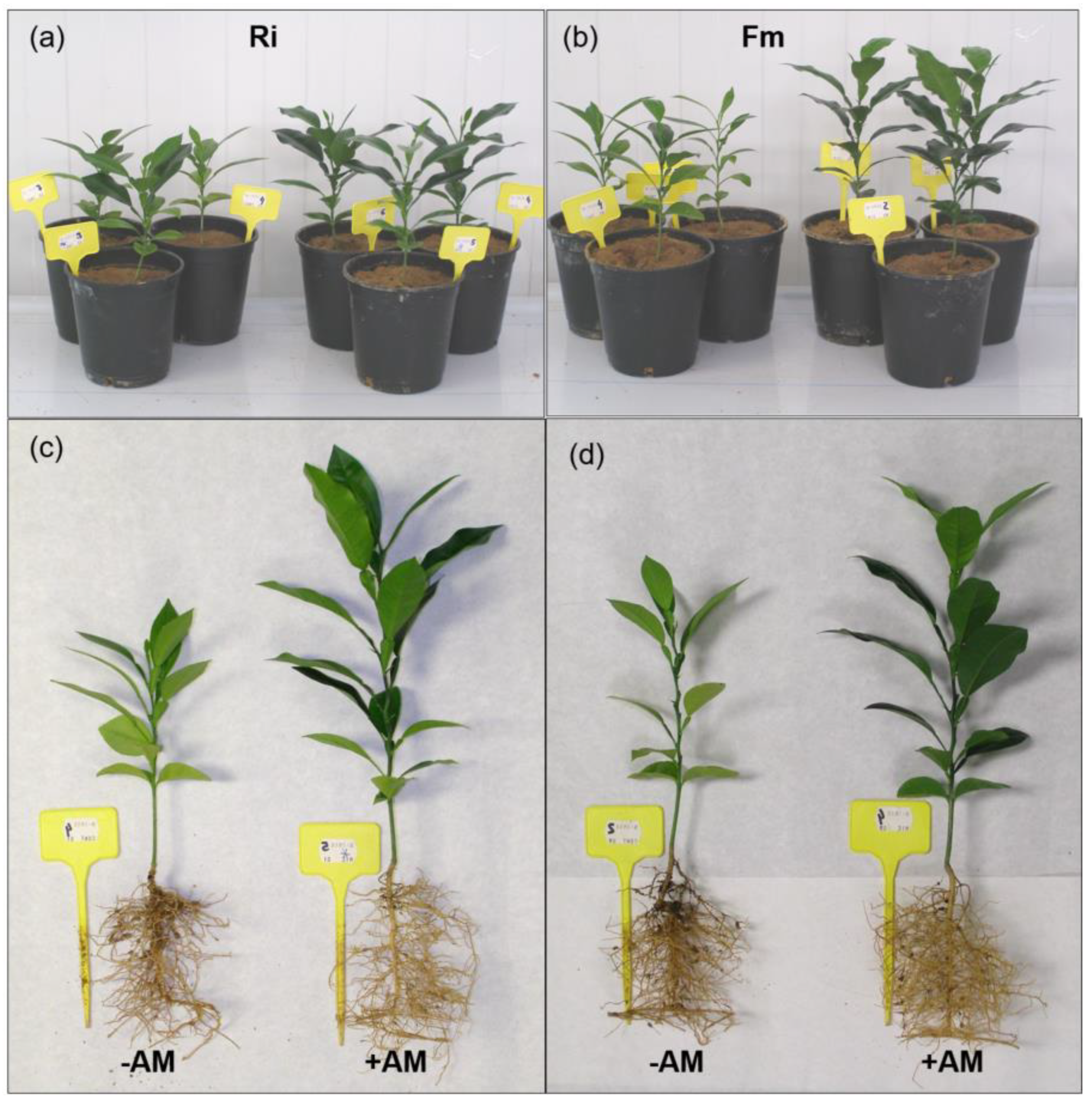

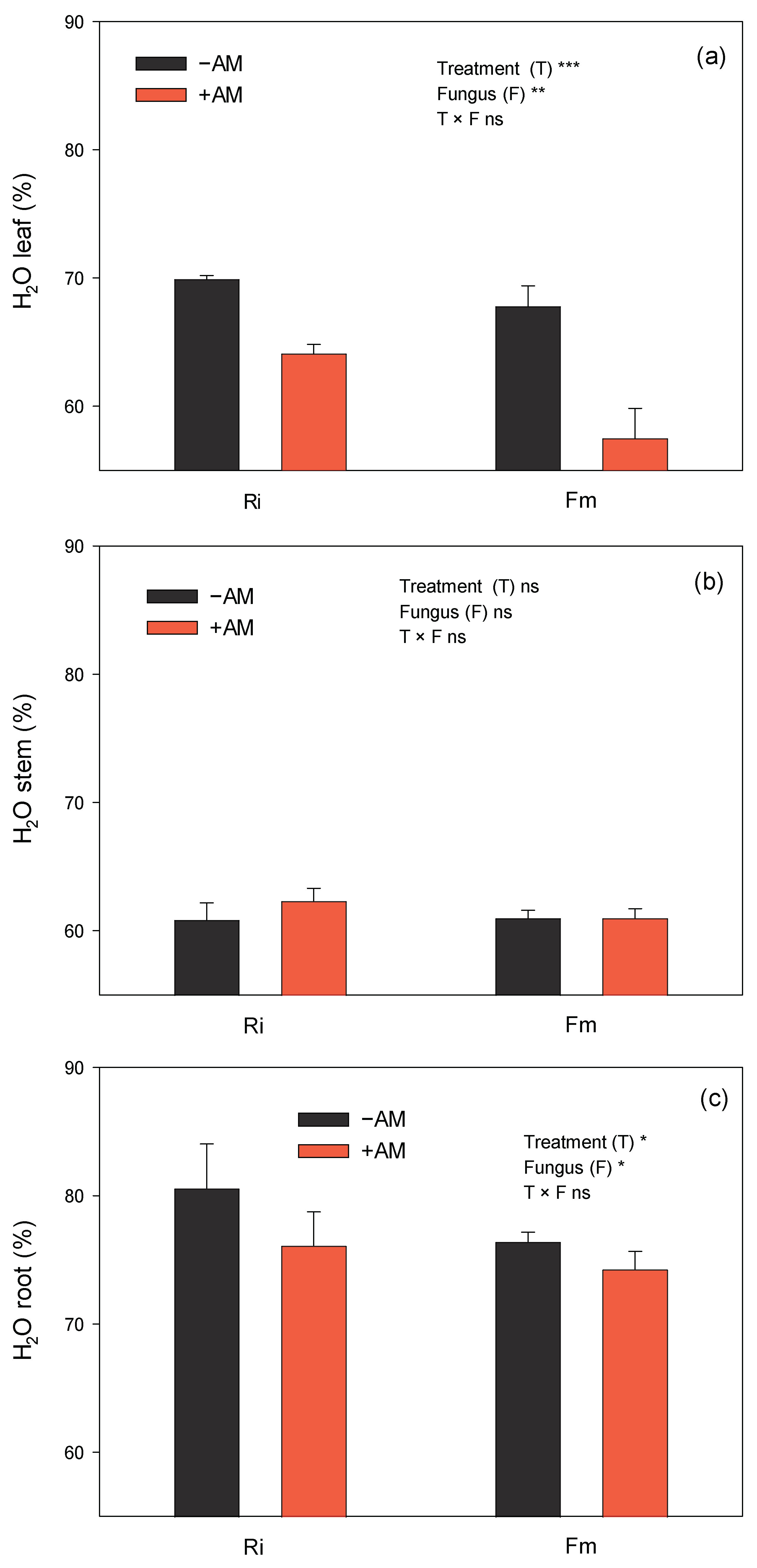
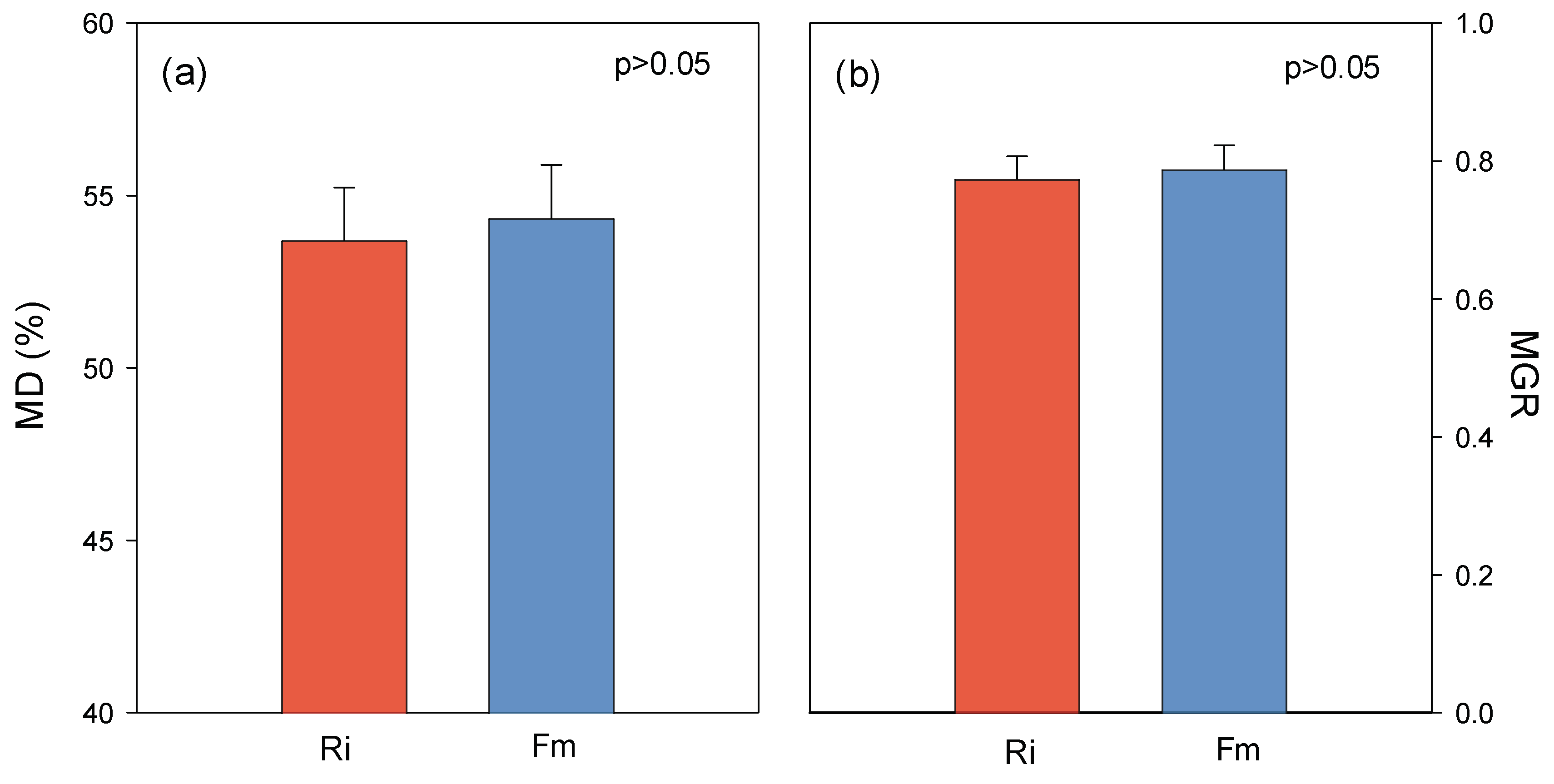
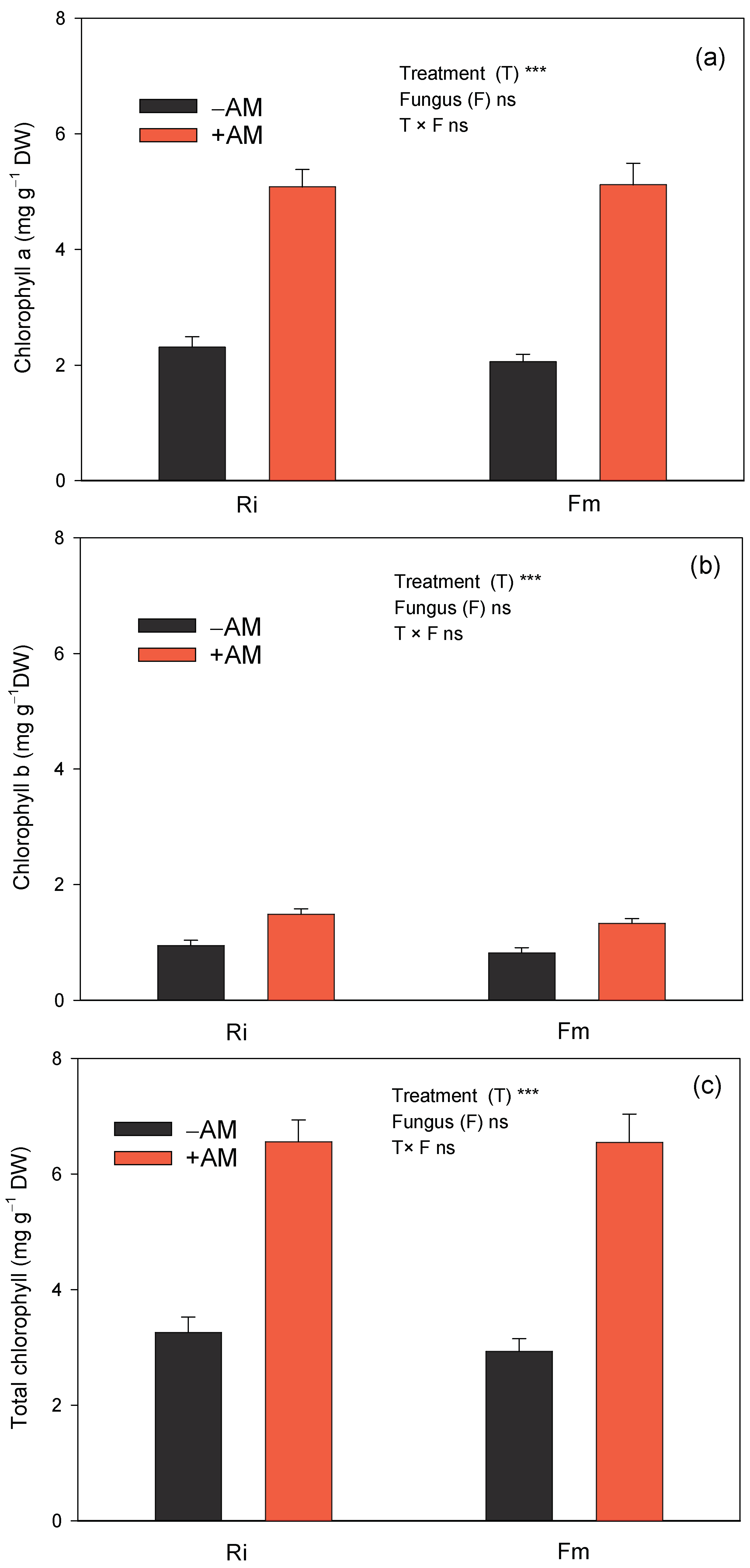
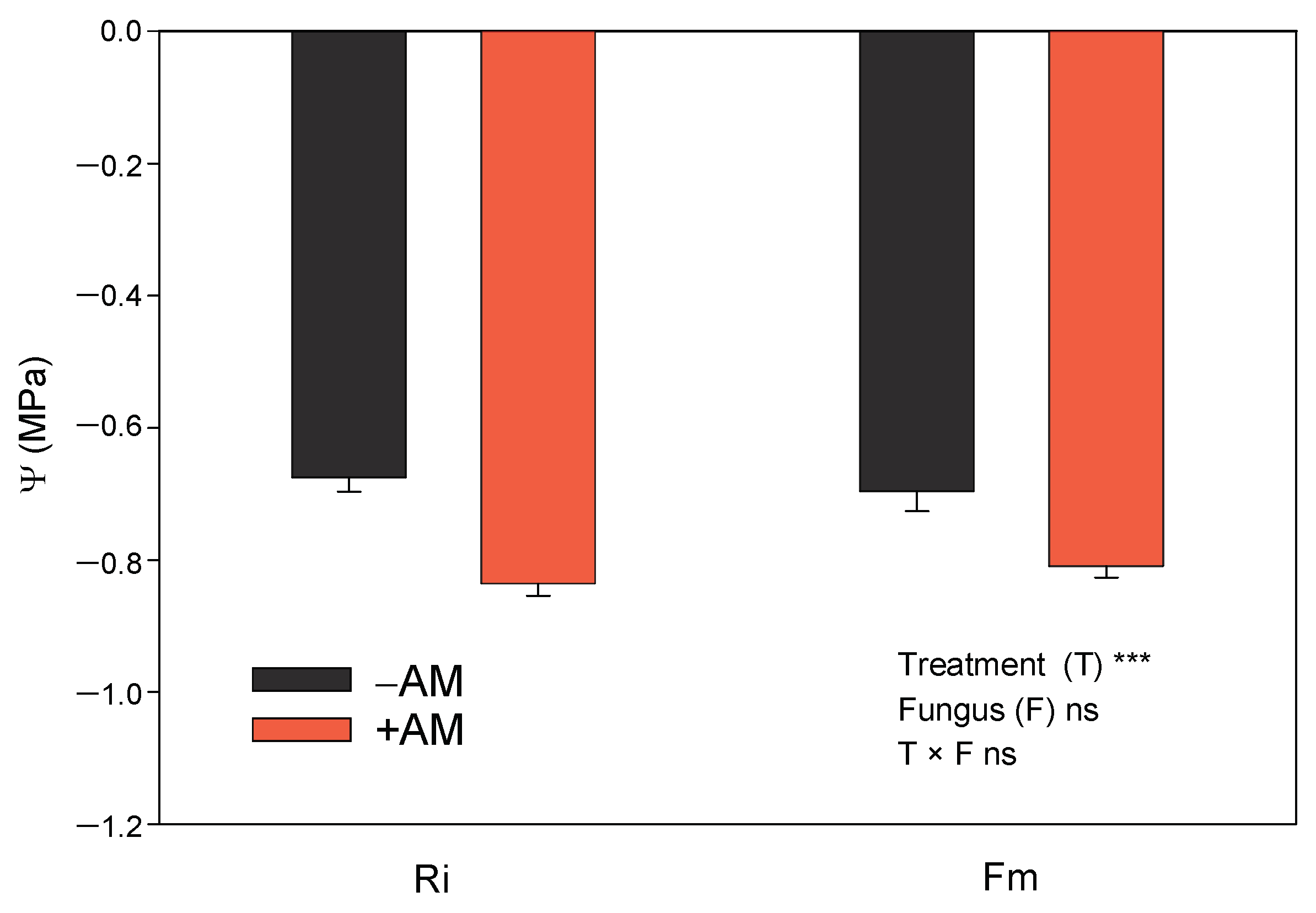
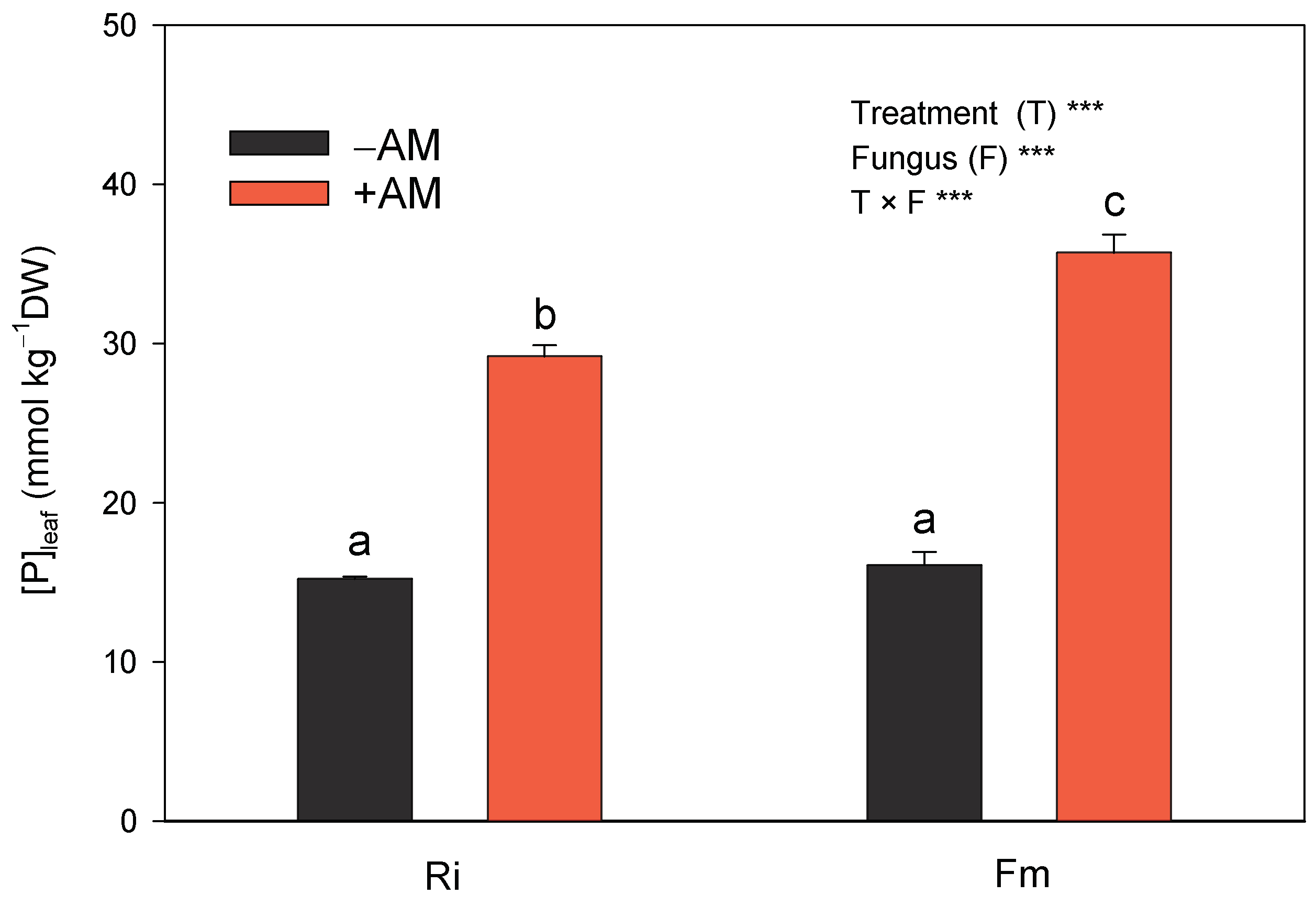
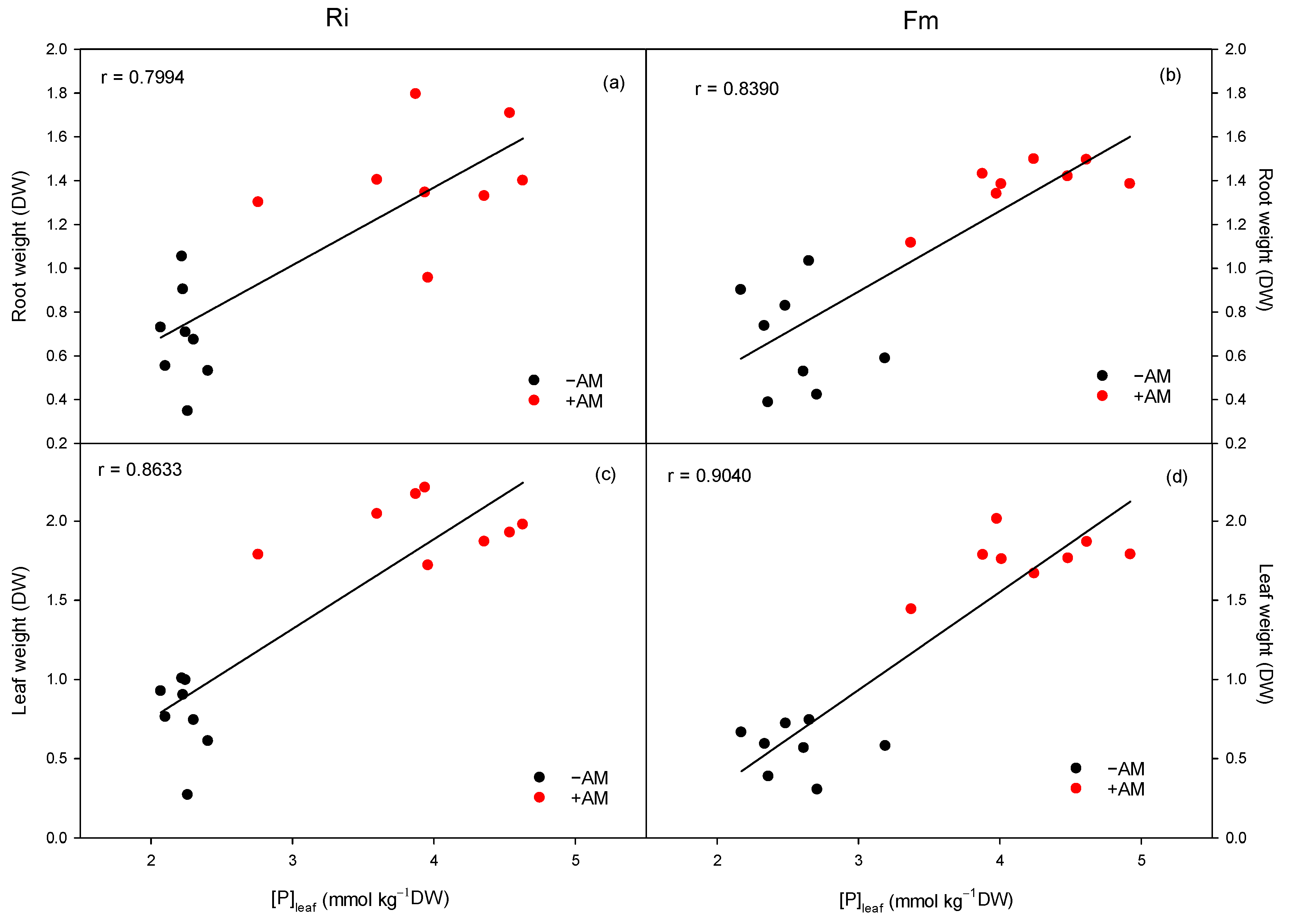
| Colonization Percentage (%) | ||
|---|---|---|
| Ri | −AM | 22.3 a |
| +AM | 86.6 c | |
| Fm | −AM | 22.6 a |
| +AM | 64.1 b | |
| ANOVA | *** | |
| Fresh Weight (g) | Dry Weight (g) | ||||||||||
|---|---|---|---|---|---|---|---|---|---|---|---|
| AM | Root | Leaf | Shoot | Plant | Root/Shoot | Root | Leaf | Shoot | Plant | Root/Shoot | |
| −AM | 3.14 | 2.26 | 3.01 | 6.3 | 1.11 | 0.68 | 1.21 | 0.96 | 1.60 | 0.73 | |
| +AM | 5.19 | 4.82 | 6.17 | 11.4 | 0.86 | 1.36 | 1.54 | 2.31 | 3.47 | 0.56 | |
| Fungus | |||||||||||
| Ri | 4.31 | 4.14 | 5.13 | 9.6 | 0.92 | 0.99 | 1.57 | 1.90 | 2.65 | 0.59 | |
| Fm | 4.02 | 2.94 | 4.05 | 8.1 | 1.04 | 1.05 | 1.19 | 1.38 | 2.41 | 0.70 | |
| Ri | −AM | 3.41 | 2.76 | 3.59 | 7.3 | 1.04 | 0.68 | 1.47 | 1.08 | 1.68 | 0.66 |
| +AM | 5.21 | 5.52 | 6.67 | 11.9 | 0.81 | 1.30 | 1.66 | 2.71 | 3.63 | 0.53 | |
| Fm | −AM | 2.87 | 1.76 | 2.43 | 5.3 | 1.17 | 0.68 | 0.96 | 0.83 | 1.51 | 0.80 |
| +AM | 5.17 | 4.12 | 5.67 | 10.8 | 0.92 | 1.42 | 1.42 | 1.92 | 3.31 | 0.59 | |
| ANOVA | |||||||||||
| AM | *** | *** | *** | *** | *** | *** | *** | *** | *** | *** | |
| Fungus (F) | ns | *** | ** | * | ns | ns | *** | ** | ns | ** | |
| AM × F | ns | ns | ns | ns | ns | ns | ns | ns | ns | ns | |
| AM | N | K | Ca | Mg | Na | B | Fe | Cu | Mn | Zn | |
|---|---|---|---|---|---|---|---|---|---|---|---|
| −AM | 3.66 | 589 | 695 | 156.7 | 136 | 4.09 | 1.53 | 0.477 | 0.672 | 0.313 | |
| +AM | 2.75 | 341 | 522 | 91.5 | 111 | 2.40 | 1.49 | 0.314 | 0.548 | 0.251 | |
| Fungus | |||||||||||
| Ri | 3.29 | 470 | 593 | 122.8 | 122 | 3.09 | 1.40 | 0.492 | 0.590 | 0.345 | |
| Fm | 3.11 | 460 | 623 | 125.4 | 125 | 3.40 | 1.63 | 0.299 | 0.629 | 0.220 | |
| Ri | −AM | 3.76 | 567 | 685 | 160.2 | 146 | 3.96 | 1.33 | 0.650 b | 0.666 | 0.421 c |
| +AM | 2.82 | 374 | 502 | 85.3 | 99 | 2.23 | 1.46 | 0.334 a | 0.515 | 0.268 b | |
| Fm | −AM | 3.55 | 611 | 704 | 153.2 | 127 | 4.23 | 1.74 | 0.305 a | 0.677 | 0.205 a |
| +AM | 2.67 | 309 | 542 | 97.7 | 123 | 2.57 | 1.52 | 0.294 a | 0.581 | 0.234 ab | |
| ANOVA | |||||||||||
| AM | *** | *** | *** | *** | * | *** | * | *** | *** | ** | |
| Fungus (F) | * | ns | ns | ns | ns | ns | ns | *** | ns | *** | |
| AM × F | ns | ns | ns | ns | ns | ns | ns | *** | ns | *** | |
Disclaimer/Publisher’s Note: The statements, opinions and data contained in all publications are solely those of the individual author(s) and contributor(s) and not of MDPI and/or the editor(s). MDPI and/or the editor(s) disclaim responsibility for any injury to people or property resulting from any ideas, methods, instructions or products referred to in the content. |
© 2024 by the authors. Licensee MDPI, Basel, Switzerland. This article is an open access article distributed under the terms and conditions of the Creative Commons Attribution (CC BY) license (https://creativecommons.org/licenses/by/4.0/).
Share and Cite
Navarro, J.M.; Morte, A. Arbuscular Mycorrhizal Fungi as Biofertilizers to Increase the Plant Quality of Sour-Orange Seedlings. Agronomy 2024, 14, 230. https://doi.org/10.3390/agronomy14010230
Navarro JM, Morte A. Arbuscular Mycorrhizal Fungi as Biofertilizers to Increase the Plant Quality of Sour-Orange Seedlings. Agronomy. 2024; 14(1):230. https://doi.org/10.3390/agronomy14010230
Chicago/Turabian StyleNavarro, Josefa María, and Asunción Morte. 2024. "Arbuscular Mycorrhizal Fungi as Biofertilizers to Increase the Plant Quality of Sour-Orange Seedlings" Agronomy 14, no. 1: 230. https://doi.org/10.3390/agronomy14010230
APA StyleNavarro, J. M., & Morte, A. (2024). Arbuscular Mycorrhizal Fungi as Biofertilizers to Increase the Plant Quality of Sour-Orange Seedlings. Agronomy, 14(1), 230. https://doi.org/10.3390/agronomy14010230





